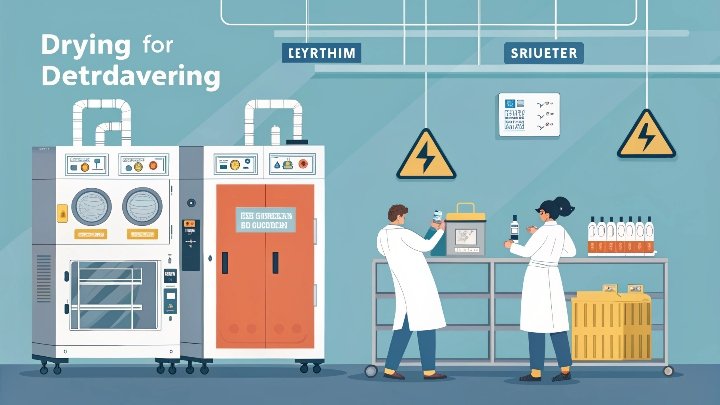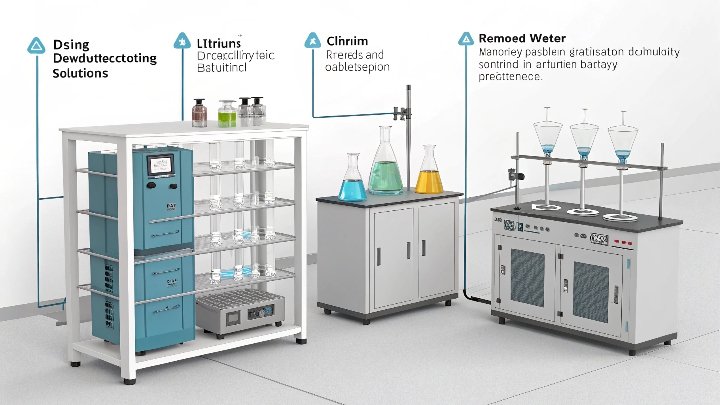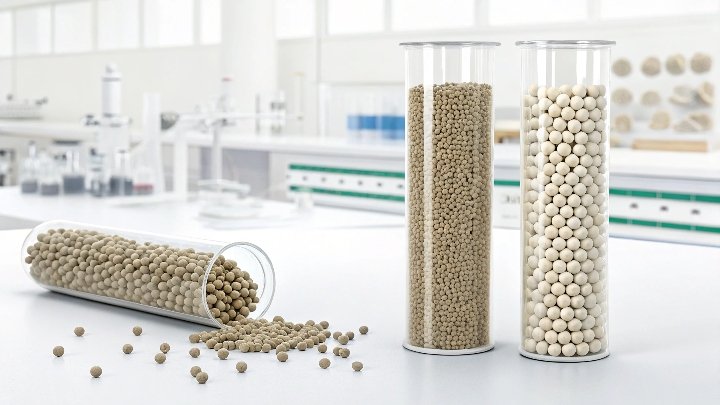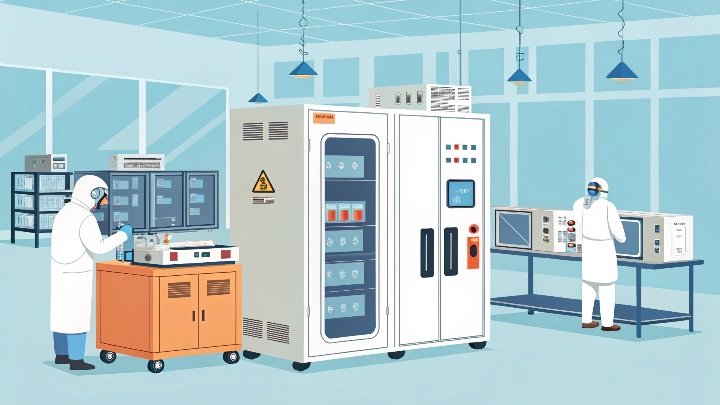Too much moisture in a lithium battery electrolyte can ruin performance. I saw this happen before, and it was frustrating. Now I want to share a simple way to fix it.
CNM 4A molecular sieve excels at trapping water. It pulls moisture from the electrolyte and does it with high efficiency. It does not mess up the electrolyte’s composition or create pollution. That is why I think it is the clear superstar in this field.
I remember watching a client struggle with short-circuits and reduced battery life. We found that the electrolyte had too much water. When we introduced CNM 4A molecular sieve, we noticed a big improvement. Now I want to explain the reasons behind this and explore the details of how molecular sieves work.
Why Molecular Sieves Are the Unsung Heroes of Lithium Batteries?
High water content hurts batteries. It boosts internal resistance, lowers capacity, and can even lead to unwanted reactions. I felt overwhelmed when I first learned that moisture can cause fires in lithium batteries. I realized that a stable drying agent is vital.
Molecular sieves stand out because they grab hold of water at a targeted size. They do not just absorb anything. They filter and trap water molecules so the electrolyte remains stable. That is why I see them as silent defenders of lithium battery performance.
I want to break down how molecular sieves help on a deeper level. This section will detail their special properties and compare them with other drying materials. I will also include a table for clarity.
Selective Adsorption Explained
A molecular sieve has pores of a certain size. In the case of a 4A molecular sieve, the pore size is around 4 angstroms. These pores catch molecules of similar size, like water. When water molecules enter the pores, they are held by weak forces known as van der Waals forces. This selective process keeps other substances in the electrolyte untouched. That means no change occurs to vital electrolyte components. I value this because it makes sure the electrolyte composition stays balanced.
Why Other Drying Methods Fall Short
I used to see people rely on vacuum drying or heating methods to remove water. Those steps can be expensive and time-consuming. Sometimes, they also risk damaging the electrolyte. Molecular sieves offer a simpler approach. They can be regenerated and reused if certain conditions are met. That extends their lifecycle. It also keeps costs more predictable. From my viewpoint, that is a big advantage compared to single-use drying agents.
Table: Quick Comparison of Drying Methods
| Drying Method | Cost | Impact on Electrolyte | Reusability |
|---|---|---|---|
| Vacuum/Heating | High | Possible degradation | Limited |
| Chemical Desiccants | Medium | Might leave residues | Sometimes limited |
| Molecular Sieves (4A) | Medium | Very low, no residues | Reusable |
In my experience, I have seen how a 4A molecular sieve maintains strong adsorption capacity over multiple cycles. It also shows great chemical stability, so it does not break down in harsh environments. The lack of byproducts is important for maintaining the purity of the electrolyte solution. That purity has a major effect on battery stability. I have heard many stories of battery packs that fail after a short time because the electrolyte was compromised by residual water. With the right molecular sieve, such problems go away. That is the reason I believe molecular sieves are the hidden backbone of reliable lithium batteries.
By combining strong adsorption capacity, reusability, and minimal side effects, molecular sieves rise above other methods. I find that they strike a balance between cost and performance, which is valuable for large-scale lithium battery production. When I help clients choose a drying method, I always urge them to look at the long-term benefits. Molecular sieves often come out on top.
The Top Contender: 4A Molecular Sieves Take the Stage?
Excess water can weaken a battery’s capacity and even cause short circuits. I felt stressed whenever someone told me about an unexpected battery failure. I learned that removing water at the electrolyte stage is essential.
4A molecular sieves are the leading stars. They trap only the right size of molecules, which are water molecules, leaving other components alone. That targeted approach is what makes them so effective.
I see 4A molecular sieves leading the charge because they have a structure that is perfect for moisture control in lithium batteries. Here is a closer look at their special traits, plus some personal observations.
Pore Size and Adsorption Efficiency
4A molecular sieves have a pore size that best suits water molecules. This ensures efficient water trapping. In my work, I have observed that a single pass of electrolyte through 4A molecular sieve material can drop the water content dramatically. That is a real benefit for lithium battery manufacturers, who need consistent dryness levels to assure top battery performance.
Large Total Adsorption Capacity
When I talk with colleagues, they often ask me if these sieves get saturated too fast. The answer is that 4A molecular sieves have a high adsorption capacity. They can hold a large amount of water relative to their mass. This means less frequent replacement or regeneration. That translates into cost savings in a production setting. I have used them in continuous production lines, and the stable adsorption performance gave me confidence in the final product.
Minimal Impact on the Electrolyte
I used to worry about possible contamination or chemical reactions between the adsorbent and the electrolyte. With 4A molecular sieves, I noticed that the electrolyte composition remains intact. That is because these sieves target water molecules specifically. They do not strip out additives or salts that are important for battery performance.
Long Service Life
In many industries, the total cost of ownership is a major concern. 4A molecular sieves can be regenerated by heating or by changing pressure conditions, depending on the design. That helps them last a long time before replacement is needed. I have seen setups that can run for many cycles with no noticeable reduction in adsorption capacity.
How It All Works in Practice
An example that comes to mind is a factory line that was producing large volumes of lithium-ion batteries. They faced swelling issues in certain battery packs. The root cause was linked to residual moisture in the electrolyte. When we shifted to CNM 4A molecular sieves, those swelling issues dropped significantly. The maintenance team also appreciated that the sieves were easy to handle and did not require special disposal.
These reasons highlight why I hold 4A molecular sieves in high regard. They deliver consistent performance, can be reused, and do not tamper with the delicate balance of the electrolyte. That is why I always recommend them as the top choice for manufacturers who want to keep their batteries safe and functional.
How Molecular Sieves Keep Electrolytes Dry and Batteries Happy?
When I face a battery issue, I check for signs of moisture first. I saw how water in the electrolyte can destroy battery life. That experience led me to seek a reliable drying solution.
Molecular sieves maintain dryness by locking in water. They use their specific pore size to stop water from causing harm. That is how they keep the battery happy and safe.
I want to explain how the drying process operates at the core. It can sound technical, but I will keep it straightforward. I will also include a brief table that shows why dryness matters for battery health.
The Nature of the Electrolyte
A lithium battery electrolyte typically has organic solvents, lithium salts, and additives. Some examples of common solvents include ethylene carbonate, dimethyl carbonate, and others that help with ion flow. Water can slip into this mix during storage or manufacturing. Even small amounts of water can form unwanted byproducts. In my experience, these byproducts can degrade the battery’s cathode and cause side reactions.
The Drying Mechanism
A 4A molecular sieve, with its uniform pore structure, filters the water molecules as the electrolyte passes through or near it. The water remains stuck in the pores, while the rest of the solution stays untouched. This process is called selective adsorption. By capturing water, the molecular sieve guards the lithium salts and organic solvents from hydrolysis or decomposition. I have seen how even a small improvement in moisture control can lead to longer cycle life and more stable discharge rates.
Benefits for Safety and Performance
Dry electrolytes are not just about capacity. In extreme cases, moisture can ignite or lead to heat buildup. When I read about lithium battery explosions, I noticed many times that water was the culprit. By using a molecular sieve, we reduce that risk. This leads to safer battery packs, which is especially important for electric vehicles or large energy storage systems. I once visited a facility that had strict safety standards for their battery products. They tried different drying agents, but eventually switched to 4A molecular sieves because they offered better water removal. After that change, the product quality improved, and safety concerns dropped.
Table: Why Dryness Matters
| Aspect | Wet Electrolyte Risk | Dry Electrolyte Advantage |
|---|---|---|
| Battery Life | Reduced cycle life | Longer cycle life |
| Internal Safety | Risk of short circuits or sparks | Lower risk of thermal events |
| Performance | Lower capacity, slow charging | Higher capacity, stable charging |
Real-World Applications
I have also consulted on lab-scale experiments that looked at how different adsorbents perform in removing water from battery electrolytes. The data showed that molecular sieves gave the best balance between quick adsorption and minimal effect on other components. Those results matched my own hands-on observations. If we want a steady supply of high-quality battery electrolytes, molecular sieves offer a straightforward path.
These insights highlight why dryness is so key in battery health. I think about how vital it is to maintain safe and reliable products, especially as lithium batteries power so many devices. The right molecular sieve can prevent a small moisture problem from becoming a big hazard.
Conclusion
I believe CNM 4A molecular sieve stands out as the leading option for safe and efficient lithium battery electrolyte drying. It is my trusted solution.






